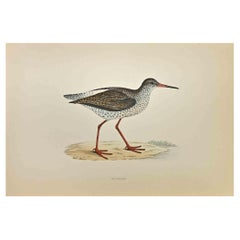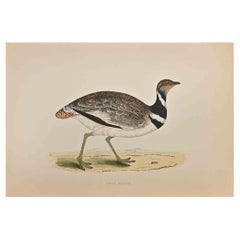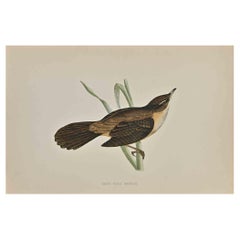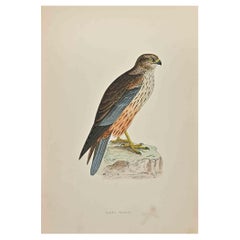1870s Animal Prints
to
90
313
12
11
1
Overall Width
to
Overall Height
to
311
3
2
2
2
2
710
1,434
2,625
1,840
31
29
67
160
102
136
246
605
362
332
678
207
130
327
317
55
17
12
10
6
6
5
5
5
4
4
4
4
4
3
3
3
3
305
20
8
5
4
12
297
91
18
Period: 1870s
Redshank - Woodcut Print by Alexander Francis Lydon - 1870
Located in Roma, IT
Redshank is a modern artwork realized in 1870 by the British artist Alexander Francis Lydon (1836-1917) .
Woodcut print, hand colored, published by London, Bell & Sons, 1870. Name...
Category
Modern 1870s Animal Prints
Materials
Woodcut
Little Bustard - Woodcut Print by Alexander Francis Lydon - 1870
Located in Roma, IT
Little Bustard is a modern artwork realized in 1870 by the British artist Alexander Francis Lydon (1836-1917) .
Woodcut print, hand colored, published by London, Bell & Sons, 1870....
Category
Modern 1870s Animal Prints
Materials
Woodcut
Black Grouse - Woodcut Print by Alexander Francis Lydon - 1870
Located in Roma, IT
Black Grouse is a modern artwork realized in 1870 by the British artist Alexander Francis Lydon (1836-1917) .
Woodcut print, hand colored, published by...
Category
Modern 1870s Animal Prints
Materials
Woodcut
Great Sedge Warbler - Woodcut Print by Alexander Francis Lydon - 1870
Located in Roma, IT
Great Sedge Warbler is a modern artwork realized in 1870 by the British artist Alexander Francis Lydon (1836-1917) .
Woodcut print, hand colored, published by London, Bell & Sons, ...
Category
Modern 1870s Animal Prints
Materials
Woodcut
Marsh Harrier - Woodcut Print by Alexander Francis Lydon - 1870
Located in Roma, IT
Marsh Harrier is a modern artwork realized in 1870 by the British artist Alexander Francis Lydon (1836-1917) .
Woodcut print, hand colored, published by London, Bell & Sons, 1870. ...
Category
Modern 1870s Animal Prints
Materials
Woodcut
Pratincole - Woodcut Print by Alexander Francis Lydon - 1870
Located in Roma, IT
Pratincole is a modern artwork realized in 1870 by the British artist Alexander Francis Lydon (1836-1917) .
Woodcut print, hand colored, published by London, Bell & Sons, 1870. Na...
Category
Modern 1870s Animal Prints
Materials
Woodcut
Meadow Pipit - Woodcut Print by Alexander Francis Lydon - 1870
Located in Roma, IT
Meadow Pipit is a modern artwork realized in 1870 by the British artist Alexander Francis Lydon (1836-1917) .
Woodcut print, hand colored, published by London, Bell & Sons, 1870. ...
Category
Modern 1870s Animal Prints
Materials
Woodcut
Sedge Warbler - Woodcut Print by Alexander Francis Lydon - 1870
Located in Roma, IT
Sedge Warbler is a modern artwork realized in 1870 by the British artist Alexander Francis Lydon (1836-1917) .
Woodcut print, hand colored, published by London, Bell & Sons, 1870....
Category
Modern 1870s Animal Prints
Materials
Woodcut
Sky Lark - Woodcut Print by Alexander Francis Lydon - 1870
Located in Roma, IT
Spotted Crake is a modern artwork realized in 1870 by the British artist Alexander Francis Lydon (1836-1917) .
Woodcut print, hand colored, published by London, Bell & Sons, 1870....
Category
Modern 1870s Animal Prints
Materials
Woodcut
Ringed Dotterel - Woodcut Print by Alexander Francis Lydon - 1870
Located in Roma, IT
Ringed Dotterel is a modern artwork realized in 1870 by the British artist Alexander Francis Lydon (1836-1917) .
Woodcut print, hand colored, published by London, Bell & Sons, 187...
Category
Modern 1870s Animal Prints
Materials
Woodcut
Little Ringed Dotterel - Woodcut Print by Alexander Francis Lydon - 1870
Located in Roma, IT
Little Ringed Dotterel is a modern artwork realized in 1870 by the British artist Alexander Francis Lydon (1836-1917) .
Woodcut print, hand colored, published by London, Bell & So...
Category
Modern 1870s Animal Prints
Materials
Woodcut
Sand Grouse - Woodcut Print by Alexander Francis Lydon - 1870
Located in Roma, IT
Sand Grouse is a modern artwork realized in 1870 by the British artist Alexander Francis Lydon (1836-1917) .
Woodcut print, hand colored, published by London, Bell & Sons, 1870. N...
Category
Modern 1870s Animal Prints
Materials
Woodcut
Rock Pipit - Woodcut Print by Alexander Francis Lydon - 1870
Located in Roma, IT
Rock Pipit is a modern artwork realized in 1870 by the British artist Alexander Francis Lydon (1836-1917) .
Woodcut print, hand colored, published by London, Bell & Sons, 1870. Na...
Category
Modern 1870s Animal Prints
Materials
Woodcut
Goldcrest - Woodcut Print by Alexander Francis Lydon - 1870
Located in Roma, IT
Goldcrest is a modern artwork realized in 1870 by the British artist Alexander Francis Lydon (1836-1917) .
Woodcut print, hand colored, published by London, Bell & Sons, 1870. Nam...
Category
Modern 1870s Animal Prints
Materials
Woodcut
Rufous Sedge Warbler - Woodcut Print by Alexander Francis Lydon - 1870
Located in Roma, IT
Rufous Sedge Warbler is a modern artwork realized in 1870 by the British artist Alexander Francis Lydon (1836-1917) .
Woodcut print, hand colored, published by London, Bell & Sons,...
Category
Modern 1870s Animal Prints
Materials
Woodcut
Patridge - Woodcut Print by Alexander Francis Lydon - 1870
Located in Roma, IT
Patridge is a modern artwork realized in 1870 by the British artist Alexander Francis Lydon (1836-1917) .
Woodcut print, hand colored, published by London, Bell & Sons, 1870. Name...
Category
Modern 1870s Animal Prints
Materials
Woodcut
$166 Sale Price
30% Off
Spur-Winged Goose - Woodcut Print by Alexander Francis Lydon - 1870
Located in Roma, IT
Spur-Winged Goose is a modern artwork realized in 1870 by the British artist Alexander Francis Lydon (1836-1917) .
Woodcut print, hand colored, published by London, Bell & Sons, 18...
Category
Modern 1870s Animal Prints
Materials
Woodcut
Parrot Crossbill - Woodcut Print by Alexander Francis Lydon - 1870
Located in Roma, IT
Parrot Crossbill is a modern artwork realized in 1870 by the British artist Alexander Francis Lydon (1836-1917) .
Woodcut print, hand colored, published by London, Bell & Sons, 187...
Category
Modern 1870s Animal Prints
Materials
Woodcut
Grey Shrike - Woodcut Print by Alexander Francis Lydon - 1870
Located in Roma, IT
Grey Shrike is a modern artwork realized in 1870 by the British artist Alexander Francis Lydon (1836-1917) .
Woodcut print, hand colored, published by London, Bell & Sons, 1870. N...
Category
Modern 1870s Animal Prints
Materials
Woodcut
Great Tit - Woodcut Print by Alexander Francis Lydon - 1870
Located in Roma, IT
Great Tit is a modern artwork realized in 1870 by the British artist Alexander Francis Lydon (1836-1917) .
Woodcut print, hand colored, published by London, Bell & Sons, 1870. Nam...
Category
Modern 1870s Animal Prints
Materials
Woodcut
Belted Kingfishfr - Woodcut Print by Alexander Francis Lydon - 1870
Located in Roma, IT
Belted Kingfishfr is a modern artwork realized in 1870 by the British artist Alexander Francis Lydon (1836-1917) .
Woodcut print, hand colored, published by London, Bell & Sons, 18...
Category
Modern 1870s Animal Prints
Materials
Woodcut
Hooded Crow - Woodcut Print by Alexander Francis Lydon - 1870
Located in Roma, IT
Hooded Crow is a modern artwork realized in 1870 by the British artist Alexander Francis Lydon (1836-1917) .
Woodcut print, hand colored, published by L...
Category
Modern 1870s Animal Prints
Materials
Woodcut
Water-Rail - Woodcut Print by Alexander Francis Lydon - 1870
Located in Roma, IT
Water-Rail is a modern artwork realized in 1870 by the British artist Alexander Francis Lydon (1836-1917) .
Woodcut print, hand colored, published by London, Bell & Sons, 1870. N...
Category
Modern 1870s Animal Prints
Materials
Woodcut
Coot - Woodcut Print by Alexander Francis Lydon - 1870
Located in Roma, IT
Coot is a modern artwork realized in 1870 by the British artist Alexander Francis Lydon (1836-1917) .
Woodcut print, hand colored, published by London, Bell & Sons, 1870. Name of ...
Category
Modern 1870s Animal Prints
Materials
Woodcut
$166 Sale Price
30% Off
Bean Coose - Woodcut Print by Alexander Francis Lydon - 1870
Located in Roma, IT
Bean Coose is a modern artwork realized in 1870 by the British artist Alexander Francis Lydon (1836-1917) .
Woodcut print, hand colored, published by London, Bell & Sons, 1870. N...
Category
Modern 1870s Animal Prints
Materials
Woodcut
Little Crake - Woodcut Print by Alexander Francis Lydon - 1870
Located in Roma, IT
Little Crake is a modern artwork realized in 1870 by the British artist Alexander Francis Lydon (1836-1917) .
Woodcut print, hand colored, published by London, Bell & Sons, 1870. ...
Category
Modern 1870s Animal Prints
Materials
Woodcut
Barbary Patridge- Woodcut Print by Alexander Francis Lydon - 1870
Located in Roma, IT
Barbary Patridge is a modern artwork realized in 1870 by the British artist Alexander Francis Lydon (1836-1917) .
Woodcut print, hand colored, published by London, Bell & Sons, 187...
Category
Modern 1870s Animal Prints
Materials
Woodcut
Curlew Sandpiper - Woodcut Print by Alexander Francis Lydon - 1870
Located in Roma, IT
Curlew Sandpiper is a modern artwork realized in 1870 by the British artist Alexander Francis Lydon (1836-1917) .
Woodcut print, hand colored, published by London, Bell & Sons, 187...
Category
Modern 1870s Animal Prints
Materials
Woodcut
Knot - Woodcut Print by Alexander Francis Lydon - 1870
Located in Roma, IT
Knot is a modern artwork realized in 1870 by the British artist Alexander Francis Lydon (1836-1917) .
Woodcut print, hand colored, published by London, Bell & Sons, 1870. Name of ...
Category
Modern 1870s Animal Prints
Materials
Woodcut
$166 Sale Price
30% Off
Macqueen's Bustard - Woodcut Print by Alexander Francis Lydon - 1870
Located in Roma, IT
Macqueen's Bustard is a modern artwork realized in 1870 by the British artist Alexander Francis Lydon (1836-1917) .
Woodcut print, hand colored, published by London, Bell & Sons, 1...
Category
Modern 1870s Animal Prints
Materials
Woodcut
Alpine Accentor - Woodcut Print by Alexander Francis Lydon - 1870
Located in Roma, IT
Alpine Accentor is a modern artwork realized in 1870 by the British artist Alexander Francis Lydon (1836-1917) .
Woodcut print, hand colored, published by London, Bell & Sons, 187...
Category
Modern 1870s Animal Prints
Materials
Woodcut
Stonechat - Woodcut Print by Alexander Francis Lydon - 1870
Located in Roma, IT
Stonechat is a modern artwork realized in 1870 by the British artist Alexander Francis Lydon (1836-1917) .
Woodcut print, hand colored, published by London, Bell & Sons, 1870. Nam...
Category
Modern 1870s Animal Prints
Materials
Woodcut
Golden Oriole - Woodcut Print by Alexander Francis Lydon - 1870
Located in Roma, IT
Golden Oriole is a modern artwork realized in 1870 by the British artist Alexander Francis Lydon (1836-1917) .
Woodcut print, hand colored, published by London, Bell & Sons, 1870. ...
Category
Modern 1870s Animal Prints
Materials
Woodcut
Ring Ouzel - Woodcut Print by Alexander Francis Lydon - 1870
Located in Roma, IT
Ring Ouzel is a modern artwork realized in 1870 by the British artist Alexander Francis Lydon (1836-1917) .
Woodcut print, hand colored, published by London, Bell & Sons, 1870. N...
Category
Modern 1870s Animal Prints
Materials
Woodcut
Dipper - Woodcut Print by Alexander Francis Lydon - 1870
Located in Roma, IT
Dipper is a modern artwork realized in 1870 by the British artist Alexander Francis Lydon (1836-1917) .
Woodcut print, hand colored, published by London, Bell & Sons, 1870. Name o...
Category
Modern 1870s Animal Prints
Materials
Woodcut
Ibis - Mixed Colored Woodcut Print - 1870
Located in Roma, IT
Ibis is a modern artwork realized in 1870. Woodcut print, hand colored, published by London, Bell & Sons, 1870. Name of the bird printed in plate.
This work is part of a print sui...
Category
Modern 1870s Animal Prints
Materials
Woodcut
Cangaroos in Danger - Lithograph by F. Specht - 1879
Located in Roma, IT
Cangaroos in Danger is a black and white lithograph realized by Friedrich Specht in 1879.
Image dimensions: 19,7 x 13,7 cm.
Original Title: Am Auftralifchen "Bufch". Dated 1879 an...
Category
Naturalistic 1870s Animal Prints
Materials
Lithograph
$232 Sale Price
30% Off
Recently Viewed
View AllMore Ways To Browse
Penguin Lithograph
Peter Klucik
Pheasant Engraving
Picasso Dove Of Peace
Picasso Le Taureau
Picasso Rooster
Ronald Smith
Rooster Print Picasso
Salvador Dali Argus
Salvador Dali Unicorn
Sam Savitt
Shore Bird Print
Space Elephant Dali
Szabolcs Bozo
The Toad Picasso
Vintage Forest Service Posters
Vintage Posters Coppertone
Warhol Siberian Tiger





